Nursing Assignment: Case Study of Type 2 Diabetes Mellitus
VerifiedAdded on 2023/06/04
|16
|4083
|494
AI Summary
This report discusses the case study of Jack Jackson, who had type 2 diabetes mellitus. It highlights the effect of insulin secretion, changes associated with DM II, medicines that can be used, and long-term control of the disease.
Contribute Materials
Your contribution can guide someone’s learning journey. Share your
documents today.

Running head: NURSING ASSIGNMENT
Nursing Assignment
Name of the Student
Name of the University
Author Note
Nursing Assignment
Name of the Student
Name of the University
Author Note
Secure Best Marks with AI Grader
Need help grading? Try our AI Grader for instant feedback on your assignments.

1NURSING ASSIGNMENT
EXECUTIVE SUMMARY
In this report, the case study of Jack Jackson is discussed. He had type 2 diabetes mellitus
(DM II). In this report, the effect of insulin secretion and the changes associated with the DM
II is discussed. The mechanism of the medicines that can be used in this disease is
highlighted. Lastly, the long- term control of the disease is also enlighten in this report.
EXECUTIVE SUMMARY
In this report, the case study of Jack Jackson is discussed. He had type 2 diabetes mellitus
(DM II). In this report, the effect of insulin secretion and the changes associated with the DM
II is discussed. The mechanism of the medicines that can be used in this disease is
highlighted. Lastly, the long- term control of the disease is also enlighten in this report.
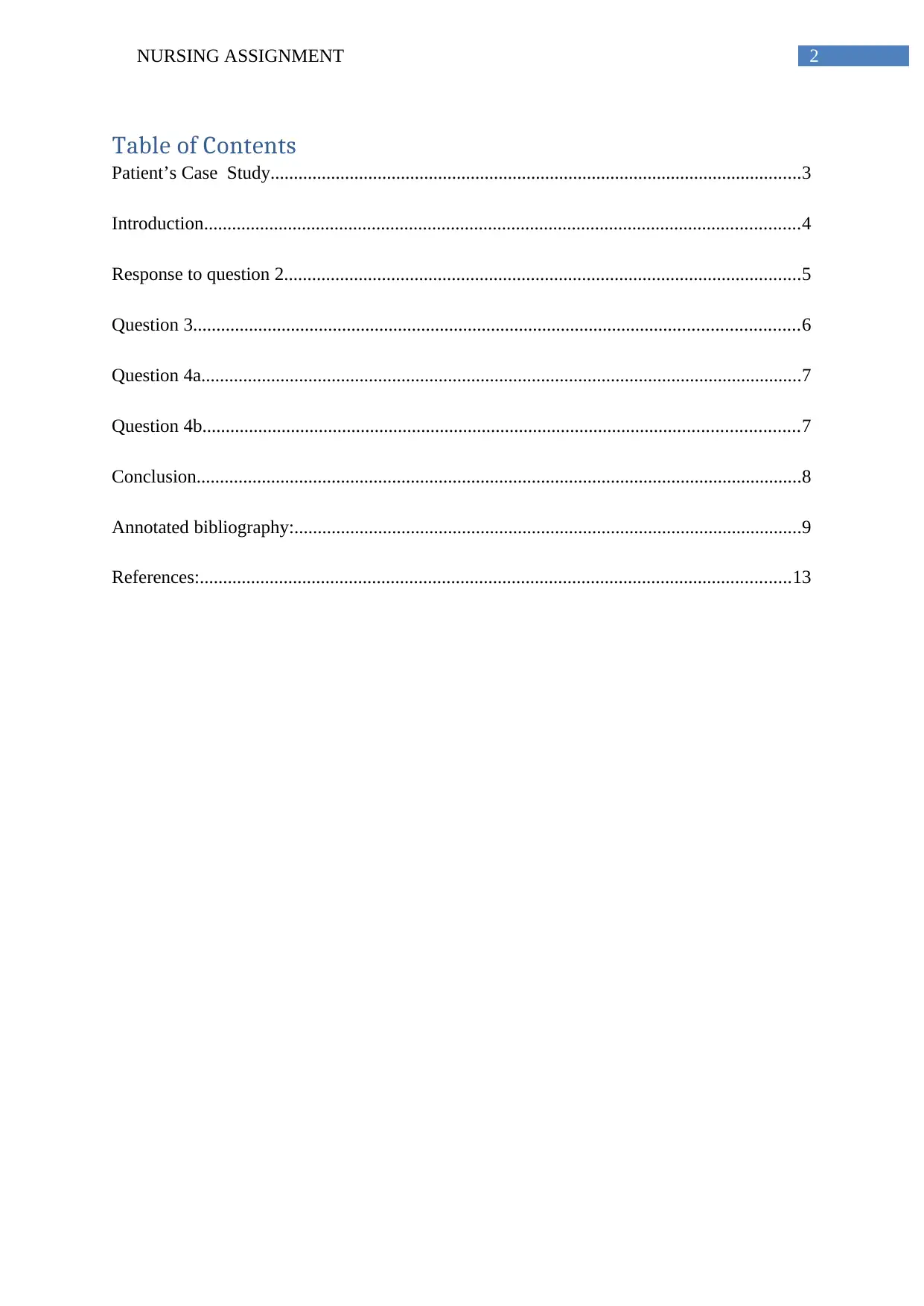
2NURSING ASSIGNMENT
Table of Contents
Patient’s Case Study..................................................................................................................3
Introduction................................................................................................................................4
Response to question 2...............................................................................................................5
Question 3..................................................................................................................................6
Question 4a.................................................................................................................................7
Question 4b................................................................................................................................7
Conclusion..................................................................................................................................8
Annotated bibliography:.............................................................................................................9
References:...............................................................................................................................13
Table of Contents
Patient’s Case Study..................................................................................................................3
Introduction................................................................................................................................4
Response to question 2...............................................................................................................5
Question 3..................................................................................................................................6
Question 4a.................................................................................................................................7
Question 4b................................................................................................................................7
Conclusion..................................................................................................................................8
Annotated bibliography:.............................................................................................................9
References:...............................................................................................................................13
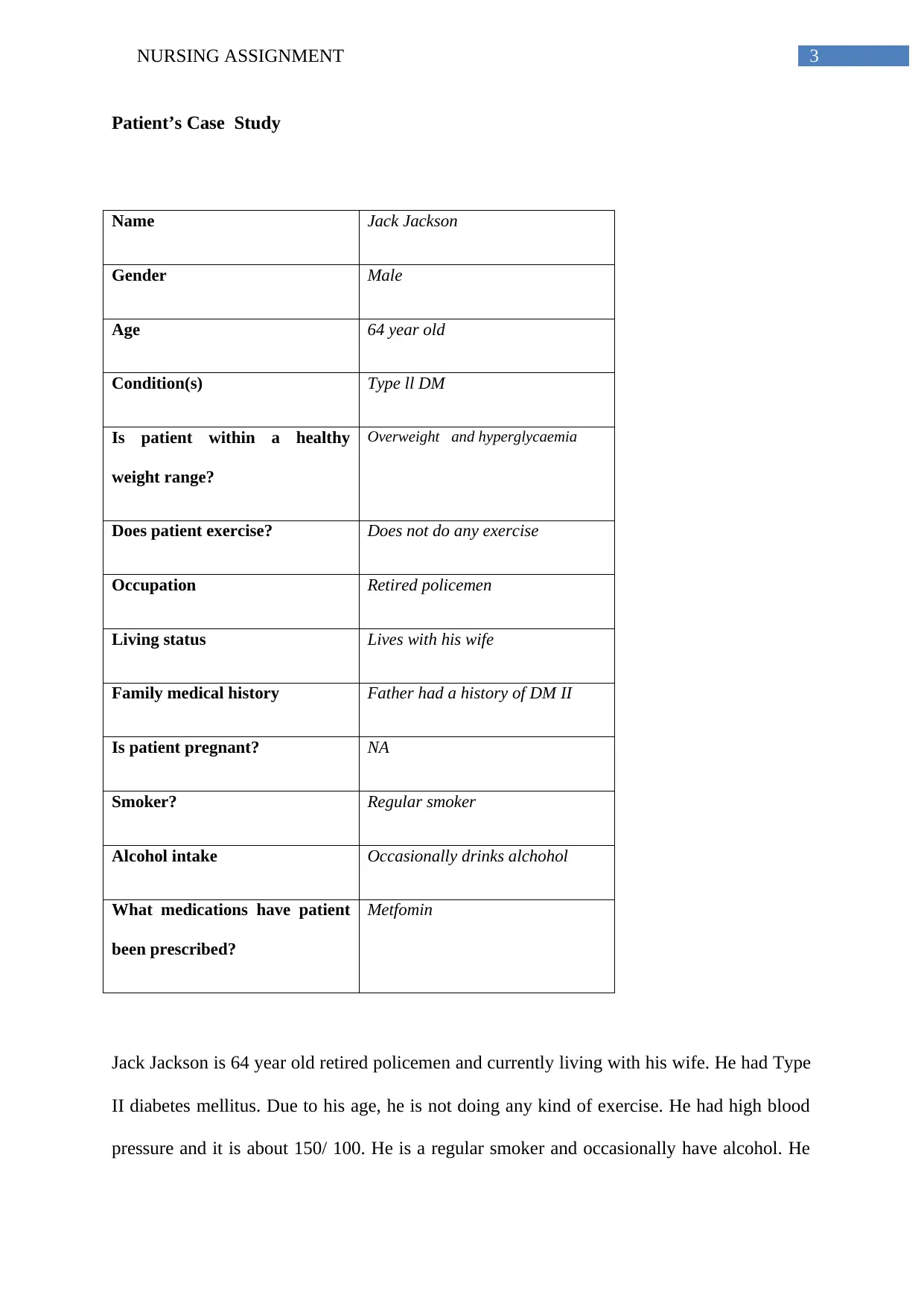
3NURSING ASSIGNMENT
Patient’s Case Study
Name Jack Jackson
Gender Male
Age 64 year old
Condition(s) Type ll DM
Is patient within a healthy
weight range?
Overweight and hyperglycaemia
Does patient exercise? Does not do any exercise
Occupation Retired policemen
Living status Lives with his wife
Family medical history Father had a history of DM II
Is patient pregnant? NA
Smoker? Regular smoker
Alcohol intake Occasionally drinks alchohol
What medications have patient
been prescribed?
Metfomin
Jack Jackson is 64 year old retired policemen and currently living with his wife. He had Type
II diabetes mellitus. Due to his age, he is not doing any kind of exercise. He had high blood
pressure and it is about 150/ 100. He is a regular smoker and occasionally have alcohol. He
Patient’s Case Study
Name Jack Jackson
Gender Male
Age 64 year old
Condition(s) Type ll DM
Is patient within a healthy
weight range?
Overweight and hyperglycaemia
Does patient exercise? Does not do any exercise
Occupation Retired policemen
Living status Lives with his wife
Family medical history Father had a history of DM II
Is patient pregnant? NA
Smoker? Regular smoker
Alcohol intake Occasionally drinks alchohol
What medications have patient
been prescribed?
Metfomin
Jack Jackson is 64 year old retired policemen and currently living with his wife. He had Type
II diabetes mellitus. Due to his age, he is not doing any kind of exercise. He had high blood
pressure and it is about 150/ 100. He is a regular smoker and occasionally have alcohol. He
Secure Best Marks with AI Grader
Need help grading? Try our AI Grader for instant feedback on your assignments.
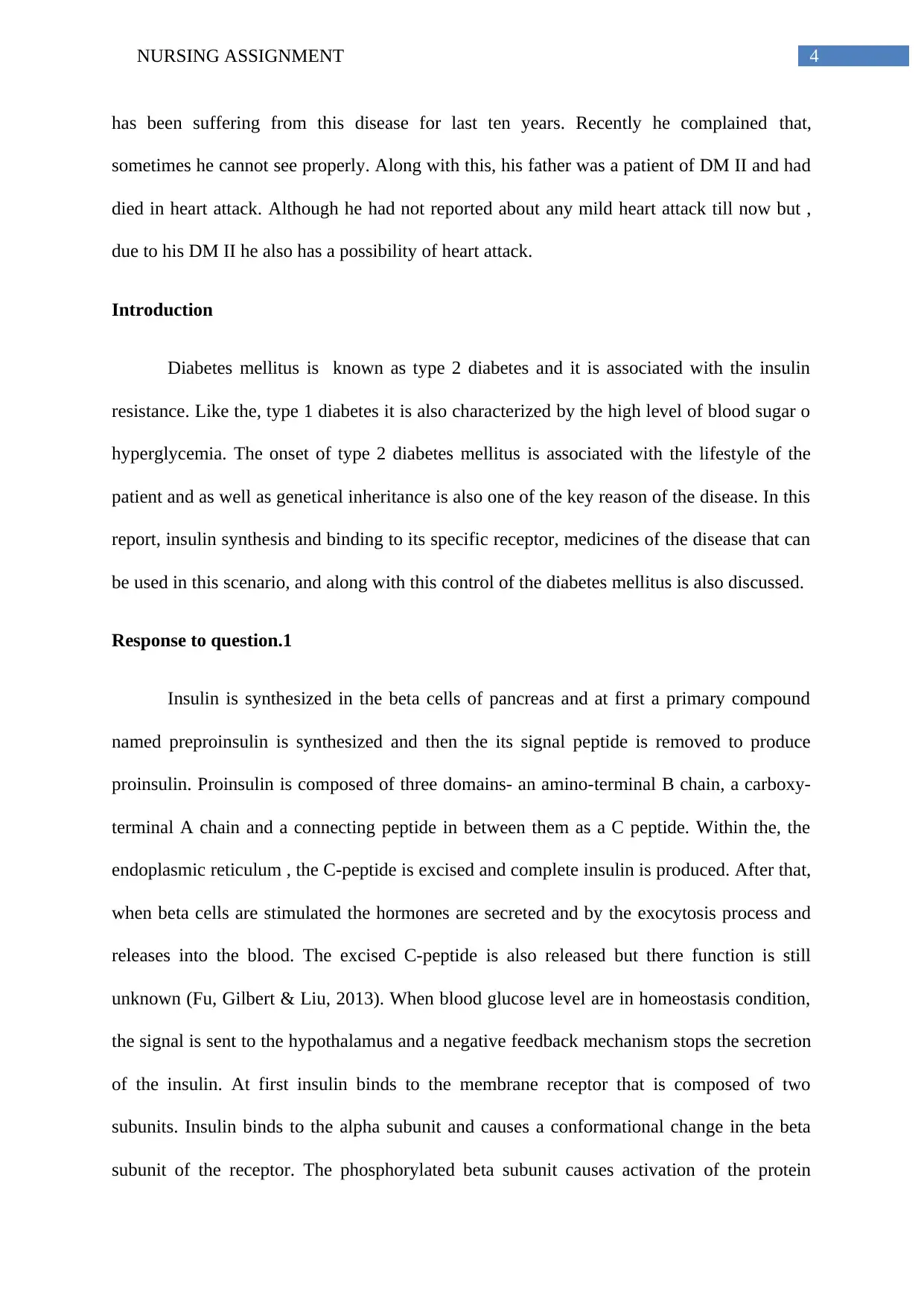
4NURSING ASSIGNMENT
has been suffering from this disease for last ten years. Recently he complained that,
sometimes he cannot see properly. Along with this, his father was a patient of DM II and had
died in heart attack. Although he had not reported about any mild heart attack till now but ,
due to his DM II he also has a possibility of heart attack.
Introduction
Diabetes mellitus is known as type 2 diabetes and it is associated with the insulin
resistance. Like the, type 1 diabetes it is also characterized by the high level of blood sugar o
hyperglycemia. The onset of type 2 diabetes mellitus is associated with the lifestyle of the
patient and as well as genetical inheritance is also one of the key reason of the disease. In this
report, insulin synthesis and binding to its specific receptor, medicines of the disease that can
be used in this scenario, and along with this control of the diabetes mellitus is also discussed.
Response to question.1
Insulin is synthesized in the beta cells of pancreas and at first a primary compound
named preproinsulin is synthesized and then the its signal peptide is removed to produce
proinsulin. Proinsulin is composed of three domains- an amino-terminal B chain, a carboxy-
terminal A chain and a connecting peptide in between them as a C peptide. Within the, the
endoplasmic reticulum , the C-peptide is excised and complete insulin is produced. After that,
when beta cells are stimulated the hormones are secreted and by the exocytosis process and
releases into the blood. The excised C-peptide is also released but there function is still
unknown (Fu, Gilbert & Liu, 2013). When blood glucose level are in homeostasis condition,
the signal is sent to the hypothalamus and a negative feedback mechanism stops the secretion
of the insulin. At first insulin binds to the membrane receptor that is composed of two
subunits. Insulin binds to the alpha subunit and causes a conformational change in the beta
subunit of the receptor. The phosphorylated beta subunit causes activation of the protein
has been suffering from this disease for last ten years. Recently he complained that,
sometimes he cannot see properly. Along with this, his father was a patient of DM II and had
died in heart attack. Although he had not reported about any mild heart attack till now but ,
due to his DM II he also has a possibility of heart attack.
Introduction
Diabetes mellitus is known as type 2 diabetes and it is associated with the insulin
resistance. Like the, type 1 diabetes it is also characterized by the high level of blood sugar o
hyperglycemia. The onset of type 2 diabetes mellitus is associated with the lifestyle of the
patient and as well as genetical inheritance is also one of the key reason of the disease. In this
report, insulin synthesis and binding to its specific receptor, medicines of the disease that can
be used in this scenario, and along with this control of the diabetes mellitus is also discussed.
Response to question.1
Insulin is synthesized in the beta cells of pancreas and at first a primary compound
named preproinsulin is synthesized and then the its signal peptide is removed to produce
proinsulin. Proinsulin is composed of three domains- an amino-terminal B chain, a carboxy-
terminal A chain and a connecting peptide in between them as a C peptide. Within the, the
endoplasmic reticulum , the C-peptide is excised and complete insulin is produced. After that,
when beta cells are stimulated the hormones are secreted and by the exocytosis process and
releases into the blood. The excised C-peptide is also released but there function is still
unknown (Fu, Gilbert & Liu, 2013). When blood glucose level are in homeostasis condition,
the signal is sent to the hypothalamus and a negative feedback mechanism stops the secretion
of the insulin. At first insulin binds to the membrane receptor that is composed of two
subunits. Insulin binds to the alpha subunit and causes a conformational change in the beta
subunit of the receptor. The phosphorylated beta subunit causes activation of the protein
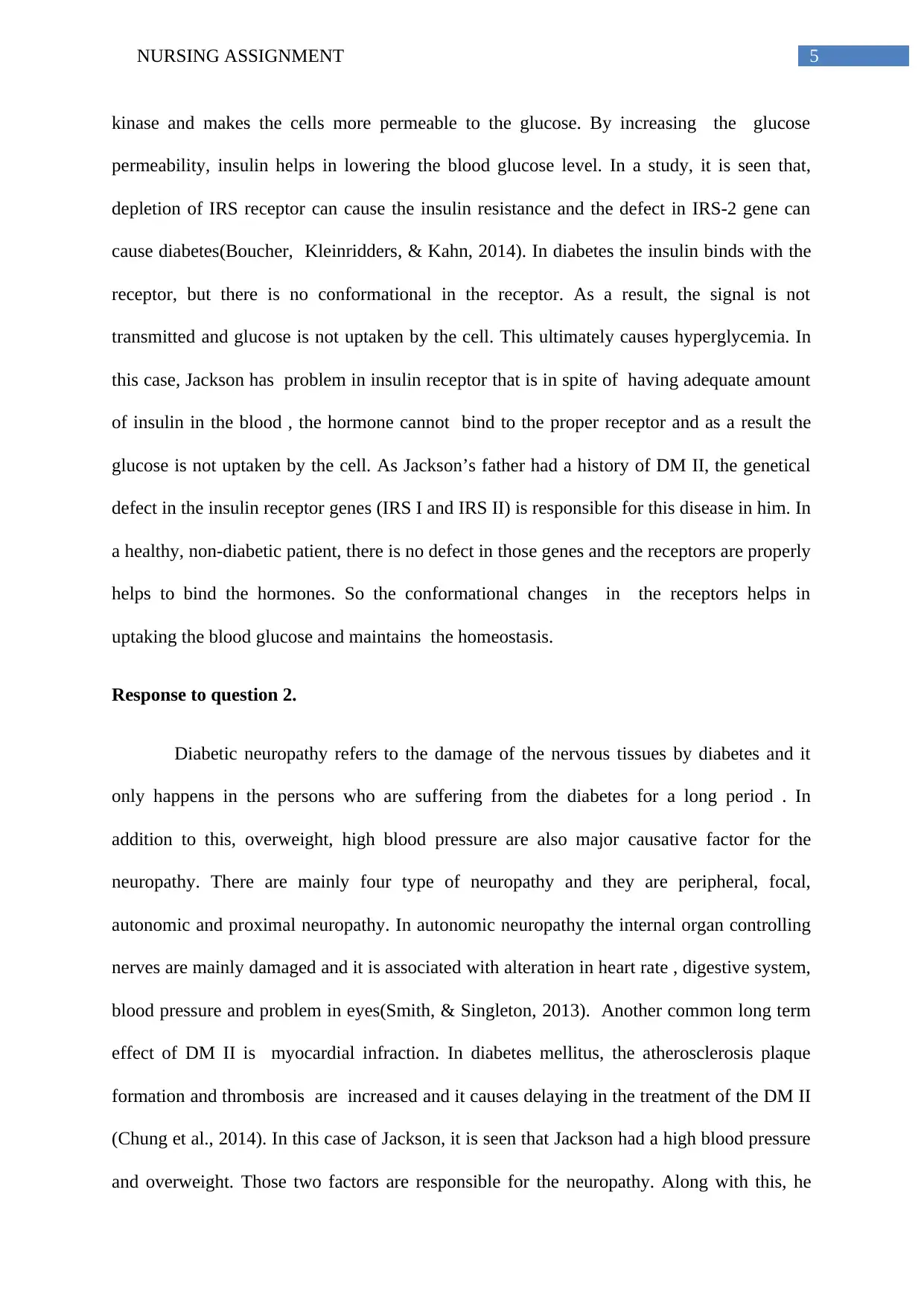
5NURSING ASSIGNMENT
kinase and makes the cells more permeable to the glucose. By increasing the glucose
permeability, insulin helps in lowering the blood glucose level. In a study, it is seen that,
depletion of IRS receptor can cause the insulin resistance and the defect in IRS-2 gene can
cause diabetes(Boucher, Kleinridders, & Kahn, 2014). In diabetes the insulin binds with the
receptor, but there is no conformational in the receptor. As a result, the signal is not
transmitted and glucose is not uptaken by the cell. This ultimately causes hyperglycemia. In
this case, Jackson has problem in insulin receptor that is in spite of having adequate amount
of insulin in the blood , the hormone cannot bind to the proper receptor and as a result the
glucose is not uptaken by the cell. As Jackson’s father had a history of DM II, the genetical
defect in the insulin receptor genes (IRS I and IRS II) is responsible for this disease in him. In
a healthy, non-diabetic patient, there is no defect in those genes and the receptors are properly
helps to bind the hormones. So the conformational changes in the receptors helps in
uptaking the blood glucose and maintains the homeostasis.
Response to question 2.
Diabetic neuropathy refers to the damage of the nervous tissues by diabetes and it
only happens in the persons who are suffering from the diabetes for a long period . In
addition to this, overweight, high blood pressure are also major causative factor for the
neuropathy. There are mainly four type of neuropathy and they are peripheral, focal,
autonomic and proximal neuropathy. In autonomic neuropathy the internal organ controlling
nerves are mainly damaged and it is associated with alteration in heart rate , digestive system,
blood pressure and problem in eyes(Smith, & Singleton, 2013). Another common long term
effect of DM II is myocardial infraction. In diabetes mellitus, the atherosclerosis plaque
formation and thrombosis are increased and it causes delaying in the treatment of the DM II
(Chung et al., 2014). In this case of Jackson, it is seen that Jackson had a high blood pressure
and overweight. Those two factors are responsible for the neuropathy. Along with this, he
kinase and makes the cells more permeable to the glucose. By increasing the glucose
permeability, insulin helps in lowering the blood glucose level. In a study, it is seen that,
depletion of IRS receptor can cause the insulin resistance and the defect in IRS-2 gene can
cause diabetes(Boucher, Kleinridders, & Kahn, 2014). In diabetes the insulin binds with the
receptor, but there is no conformational in the receptor. As a result, the signal is not
transmitted and glucose is not uptaken by the cell. This ultimately causes hyperglycemia. In
this case, Jackson has problem in insulin receptor that is in spite of having adequate amount
of insulin in the blood , the hormone cannot bind to the proper receptor and as a result the
glucose is not uptaken by the cell. As Jackson’s father had a history of DM II, the genetical
defect in the insulin receptor genes (IRS I and IRS II) is responsible for this disease in him. In
a healthy, non-diabetic patient, there is no defect in those genes and the receptors are properly
helps to bind the hormones. So the conformational changes in the receptors helps in
uptaking the blood glucose and maintains the homeostasis.
Response to question 2.
Diabetic neuropathy refers to the damage of the nervous tissues by diabetes and it
only happens in the persons who are suffering from the diabetes for a long period . In
addition to this, overweight, high blood pressure are also major causative factor for the
neuropathy. There are mainly four type of neuropathy and they are peripheral, focal,
autonomic and proximal neuropathy. In autonomic neuropathy the internal organ controlling
nerves are mainly damaged and it is associated with alteration in heart rate , digestive system,
blood pressure and problem in eyes(Smith, & Singleton, 2013). Another common long term
effect of DM II is myocardial infraction. In diabetes mellitus, the atherosclerosis plaque
formation and thrombosis are increased and it causes delaying in the treatment of the DM II
(Chung et al., 2014). In this case of Jackson, it is seen that Jackson had a high blood pressure
and overweight. Those two factors are responsible for the neuropathy. Along with this, he
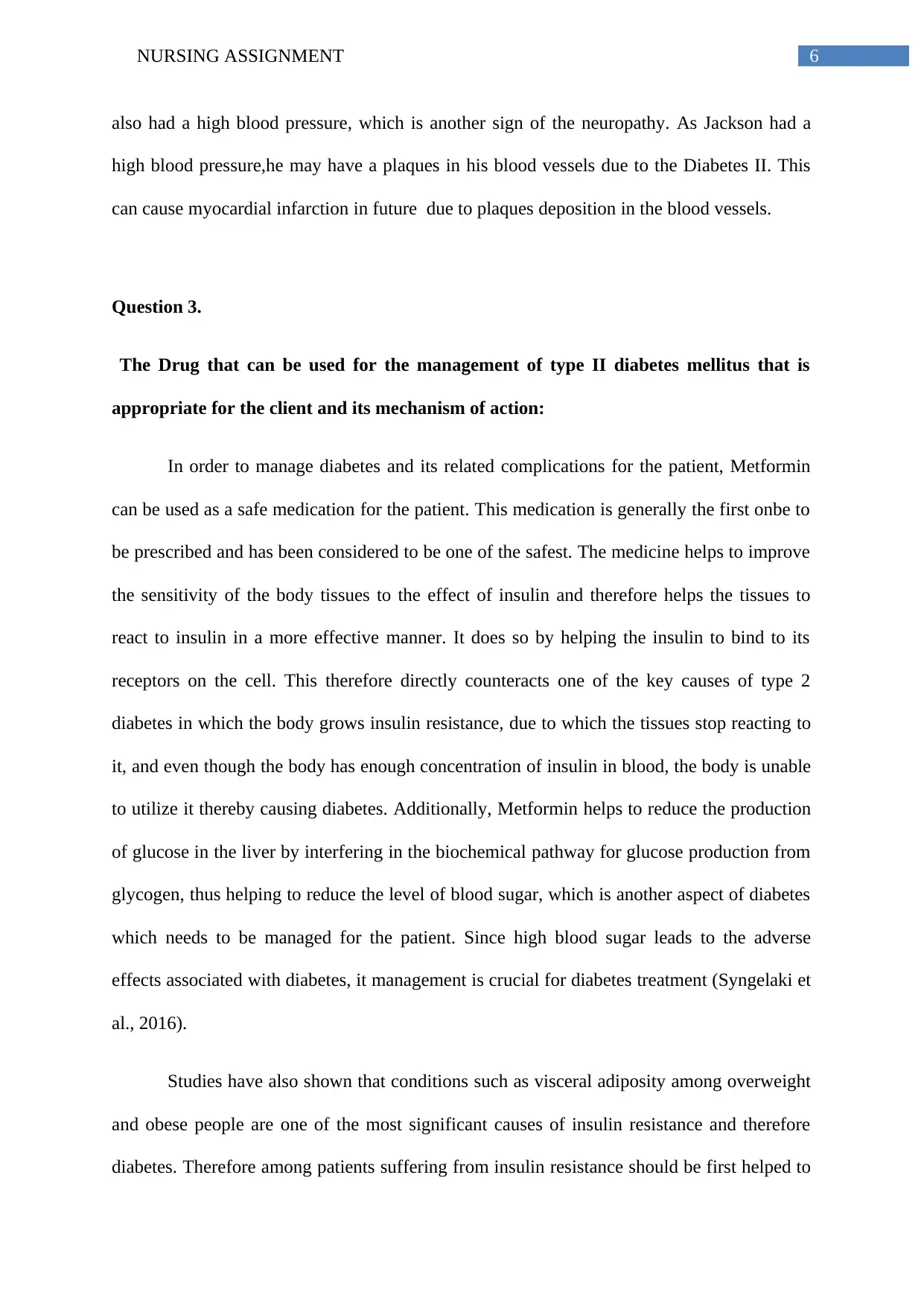
6NURSING ASSIGNMENT
also had a high blood pressure, which is another sign of the neuropathy. As Jackson had a
high blood pressure,he may have a plaques in his blood vessels due to the Diabetes II. This
can cause myocardial infarction in future due to plaques deposition in the blood vessels.
Question 3.
The Drug that can be used for the management of type II diabetes mellitus that is
appropriate for the client and its mechanism of action:
In order to manage diabetes and its related complications for the patient, Metformin
can be used as a safe medication for the patient. This medication is generally the first onbe to
be prescribed and has been considered to be one of the safest. The medicine helps to improve
the sensitivity of the body tissues to the effect of insulin and therefore helps the tissues to
react to insulin in a more effective manner. It does so by helping the insulin to bind to its
receptors on the cell. This therefore directly counteracts one of the key causes of type 2
diabetes in which the body grows insulin resistance, due to which the tissues stop reacting to
it, and even though the body has enough concentration of insulin in blood, the body is unable
to utilize it thereby causing diabetes. Additionally, Metformin helps to reduce the production
of glucose in the liver by interfering in the biochemical pathway for glucose production from
glycogen, thus helping to reduce the level of blood sugar, which is another aspect of diabetes
which needs to be managed for the patient. Since high blood sugar leads to the adverse
effects associated with diabetes, it management is crucial for diabetes treatment (Syngelaki et
al., 2016).
Studies have also shown that conditions such as visceral adiposity among overweight
and obese people are one of the most significant causes of insulin resistance and therefore
diabetes. Therefore among patients suffering from insulin resistance should be first helped to
also had a high blood pressure, which is another sign of the neuropathy. As Jackson had a
high blood pressure,he may have a plaques in his blood vessels due to the Diabetes II. This
can cause myocardial infarction in future due to plaques deposition in the blood vessels.
Question 3.
The Drug that can be used for the management of type II diabetes mellitus that is
appropriate for the client and its mechanism of action:
In order to manage diabetes and its related complications for the patient, Metformin
can be used as a safe medication for the patient. This medication is generally the first onbe to
be prescribed and has been considered to be one of the safest. The medicine helps to improve
the sensitivity of the body tissues to the effect of insulin and therefore helps the tissues to
react to insulin in a more effective manner. It does so by helping the insulin to bind to its
receptors on the cell. This therefore directly counteracts one of the key causes of type 2
diabetes in which the body grows insulin resistance, due to which the tissues stop reacting to
it, and even though the body has enough concentration of insulin in blood, the body is unable
to utilize it thereby causing diabetes. Additionally, Metformin helps to reduce the production
of glucose in the liver by interfering in the biochemical pathway for glucose production from
glycogen, thus helping to reduce the level of blood sugar, which is another aspect of diabetes
which needs to be managed for the patient. Since high blood sugar leads to the adverse
effects associated with diabetes, it management is crucial for diabetes treatment (Syngelaki et
al., 2016).
Studies have also shown that conditions such as visceral adiposity among overweight
and obese people are one of the most significant causes of insulin resistance and therefore
diabetes. Therefore among patients suffering from insulin resistance should be first helped to
Paraphrase This Document
Need a fresh take? Get an instant paraphrase of this document with our AI Paraphraser
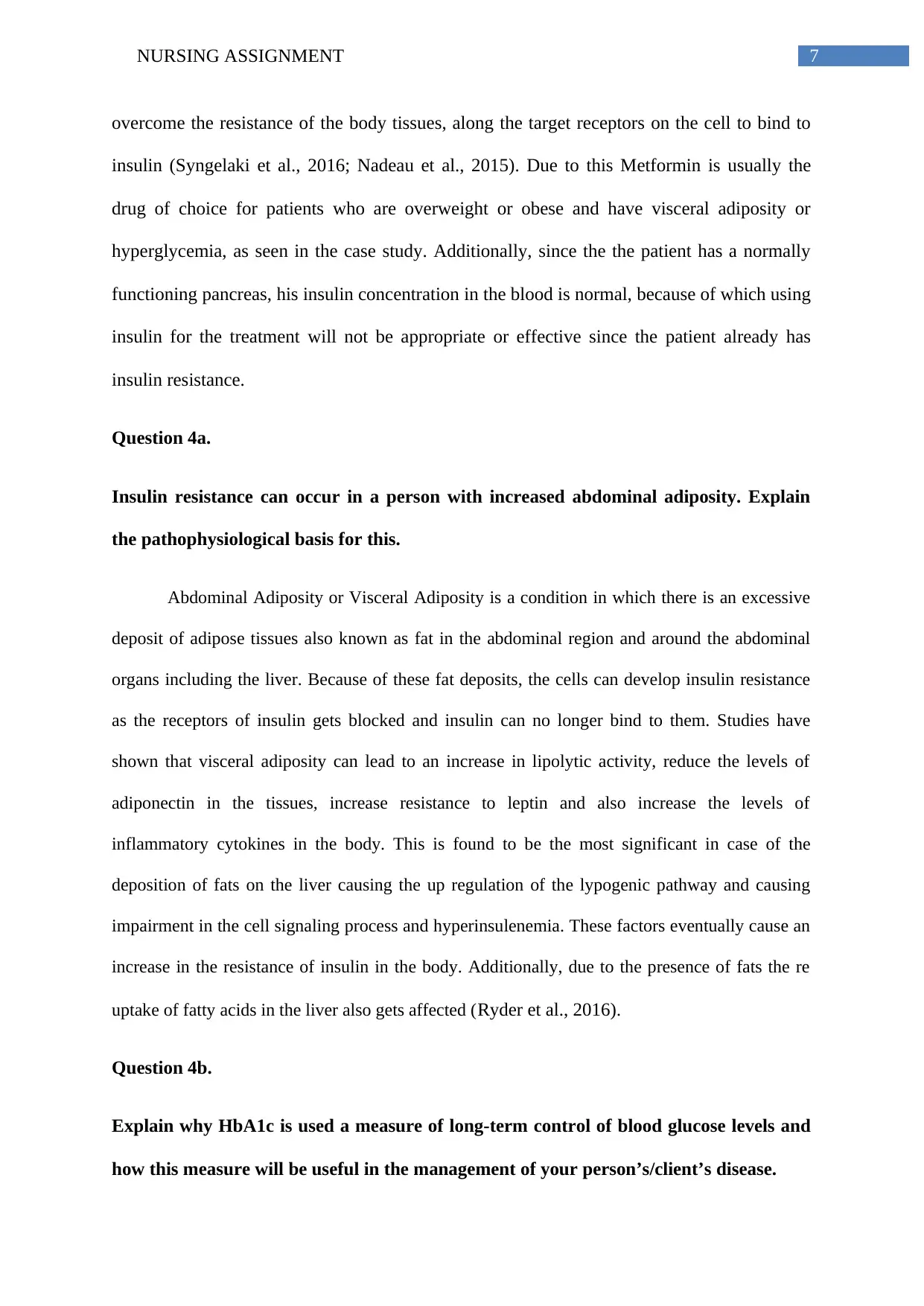
7NURSING ASSIGNMENT
overcome the resistance of the body tissues, along the target receptors on the cell to bind to
insulin (Syngelaki et al., 2016; Nadeau et al., 2015). Due to this Metformin is usually the
drug of choice for patients who are overweight or obese and have visceral adiposity or
hyperglycemia, as seen in the case study. Additionally, since the the patient has a normally
functioning pancreas, his insulin concentration in the blood is normal, because of which using
insulin for the treatment will not be appropriate or effective since the patient already has
insulin resistance.
Question 4a.
Insulin resistance can occur in a person with increased abdominal adiposity. Explain
the pathophysiological basis for this.
Abdominal Adiposity or Visceral Adiposity is a condition in which there is an excessive
deposit of adipose tissues also known as fat in the abdominal region and around the abdominal
organs including the liver. Because of these fat deposits, the cells can develop insulin resistance
as the receptors of insulin gets blocked and insulin can no longer bind to them. Studies have
shown that visceral adiposity can lead to an increase in lipolytic activity, reduce the levels of
adiponectin in the tissues, increase resistance to leptin and also increase the levels of
inflammatory cytokines in the body. This is found to be the most significant in case of the
deposition of fats on the liver causing the up regulation of the lypogenic pathway and causing
impairment in the cell signaling process and hyperinsulenemia. These factors eventually cause an
increase in the resistance of insulin in the body. Additionally, due to the presence of fats the re
uptake of fatty acids in the liver also gets affected (Ryder et al., 2016).
Question 4b.
Explain why HbA1c is used a measure of long-term control of blood glucose levels and
how this measure will be useful in the management of your person’s/client’s disease.
overcome the resistance of the body tissues, along the target receptors on the cell to bind to
insulin (Syngelaki et al., 2016; Nadeau et al., 2015). Due to this Metformin is usually the
drug of choice for patients who are overweight or obese and have visceral adiposity or
hyperglycemia, as seen in the case study. Additionally, since the the patient has a normally
functioning pancreas, his insulin concentration in the blood is normal, because of which using
insulin for the treatment will not be appropriate or effective since the patient already has
insulin resistance.
Question 4a.
Insulin resistance can occur in a person with increased abdominal adiposity. Explain
the pathophysiological basis for this.
Abdominal Adiposity or Visceral Adiposity is a condition in which there is an excessive
deposit of adipose tissues also known as fat in the abdominal region and around the abdominal
organs including the liver. Because of these fat deposits, the cells can develop insulin resistance
as the receptors of insulin gets blocked and insulin can no longer bind to them. Studies have
shown that visceral adiposity can lead to an increase in lipolytic activity, reduce the levels of
adiponectin in the tissues, increase resistance to leptin and also increase the levels of
inflammatory cytokines in the body. This is found to be the most significant in case of the
deposition of fats on the liver causing the up regulation of the lypogenic pathway and causing
impairment in the cell signaling process and hyperinsulenemia. These factors eventually cause an
increase in the resistance of insulin in the body. Additionally, due to the presence of fats the re
uptake of fatty acids in the liver also gets affected (Ryder et al., 2016).
Question 4b.
Explain why HbA1c is used a measure of long-term control of blood glucose levels and
how this measure will be useful in the management of your person’s/client’s disease.

8NURSING ASSIGNMENT
HbA1c is a type of hemoglobin, called the glycosylated hemoglobin which is used to
measure the three month average blood or plasma concentration of glucose. The test can only
measure a three month average for blood glucose, mainly because the life span of RBC is
limited to four months. This is an effective strategy for the measurement of the level of
glucose in the plasma, as it can help in the estimation of the amount of glucose molecules
bound to the red blood cells. When there is an excessive amount of glucose in the body or an
ineffective removal of glucose (due to insulin resistance), the glucose molecules starts to stick
to the red blood cells as it travels through the circulatory system and the hemoglobins pick up
the glucose due to a non enzymatic glycation pathway. This test would be useful for the
patient as it can help to understand the glucose levels of the last three months and also assess
the risks of cardiovascular problems due to diabetes (Wei et al., 2014).
Conclusion
Lastly, it can be concluded that DM II is a serious disease and the mechanism of the
insulin secretion and problems of diabetes mellitus type 2 is discussed in this report. Along
with this, the long term consequences and medicines of the disease that can be used in this
situation is also discussed.
HbA1c is a type of hemoglobin, called the glycosylated hemoglobin which is used to
measure the three month average blood or plasma concentration of glucose. The test can only
measure a three month average for blood glucose, mainly because the life span of RBC is
limited to four months. This is an effective strategy for the measurement of the level of
glucose in the plasma, as it can help in the estimation of the amount of glucose molecules
bound to the red blood cells. When there is an excessive amount of glucose in the body or an
ineffective removal of glucose (due to insulin resistance), the glucose molecules starts to stick
to the red blood cells as it travels through the circulatory system and the hemoglobins pick up
the glucose due to a non enzymatic glycation pathway. This test would be useful for the
patient as it can help to understand the glucose levels of the last three months and also assess
the risks of cardiovascular problems due to diabetes (Wei et al., 2014).
Conclusion
Lastly, it can be concluded that DM II is a serious disease and the mechanism of the
insulin secretion and problems of diabetes mellitus type 2 is discussed in this report. Along
with this, the long term consequences and medicines of the disease that can be used in this
situation is also discussed.

9NURSING ASSIGNMENT
Annotated bibliography:
1. Boucher, J., Kleinridders, A., & Kahn, C. R. (2014). Insulin receptor signaling in
normal and insulin-resistant states. Cold Spring Harbor perspectives in
biology, 6(1), a009191.
The purpose of selecting this article is to understand the signaling pathways of the insulin
receptor in normal and insulin resistance states that is imposing impact on type 2 diabetes. It
has been known from the article that insulin signaling regulates glucose, lipid, and energy
homeostasis, predominantly via action on liver, skeletal muscle, and adipose tissue. The
positive as well as the negative modulators that act on different steps of the signaling
pathway ensure a appropriate biological response to insulin in several tissues. It has been
found that two chief phenomenon causes insulin resistance in human body. Firstly genetic
mutations posses the potential to result in rare as well as severe insulin resistance, obesity has
the potential to lead to insulin resistance through a variety of mechanisms.
2. Chung, S. C., Gedeborg, R., Nicholas, O., James, S., Jeppsson, A., Wolfe, C., ... &
Jernberg, T. (2014). Acute myocardial infarction: a comparison of short-term
survival in national outcome registries in Sweden and the UK. The
Lancet, 383(9925), 1305-1312.
This article has been chosen in order to assess time trends as well as outcomes in Sweden
as well as Uk associated with acute myocardial infarction. It has been found that the
international research for acute myocardial infarction is deprived of appropriate comparison
of whole health systems. For research purpose, data from national registries on consecutive
patients registered has been used. The researchers have also compared the effectiveness of the
treatment by using indirect casemix standardization. Finally it has been found that clinically
Annotated bibliography:
1. Boucher, J., Kleinridders, A., & Kahn, C. R. (2014). Insulin receptor signaling in
normal and insulin-resistant states. Cold Spring Harbor perspectives in
biology, 6(1), a009191.
The purpose of selecting this article is to understand the signaling pathways of the insulin
receptor in normal and insulin resistance states that is imposing impact on type 2 diabetes. It
has been known from the article that insulin signaling regulates glucose, lipid, and energy
homeostasis, predominantly via action on liver, skeletal muscle, and adipose tissue. The
positive as well as the negative modulators that act on different steps of the signaling
pathway ensure a appropriate biological response to insulin in several tissues. It has been
found that two chief phenomenon causes insulin resistance in human body. Firstly genetic
mutations posses the potential to result in rare as well as severe insulin resistance, obesity has
the potential to lead to insulin resistance through a variety of mechanisms.
2. Chung, S. C., Gedeborg, R., Nicholas, O., James, S., Jeppsson, A., Wolfe, C., ... &
Jernberg, T. (2014). Acute myocardial infarction: a comparison of short-term
survival in national outcome registries in Sweden and the UK. The
Lancet, 383(9925), 1305-1312.
This article has been chosen in order to assess time trends as well as outcomes in Sweden
as well as Uk associated with acute myocardial infarction. It has been found that the
international research for acute myocardial infarction is deprived of appropriate comparison
of whole health systems. For research purpose, data from national registries on consecutive
patients registered has been used. The researchers have also compared the effectiveness of the
treatment by using indirect casemix standardization. Finally it has been found that clinically
Secure Best Marks with AI Grader
Need help grading? Try our AI Grader for instant feedback on your assignments.
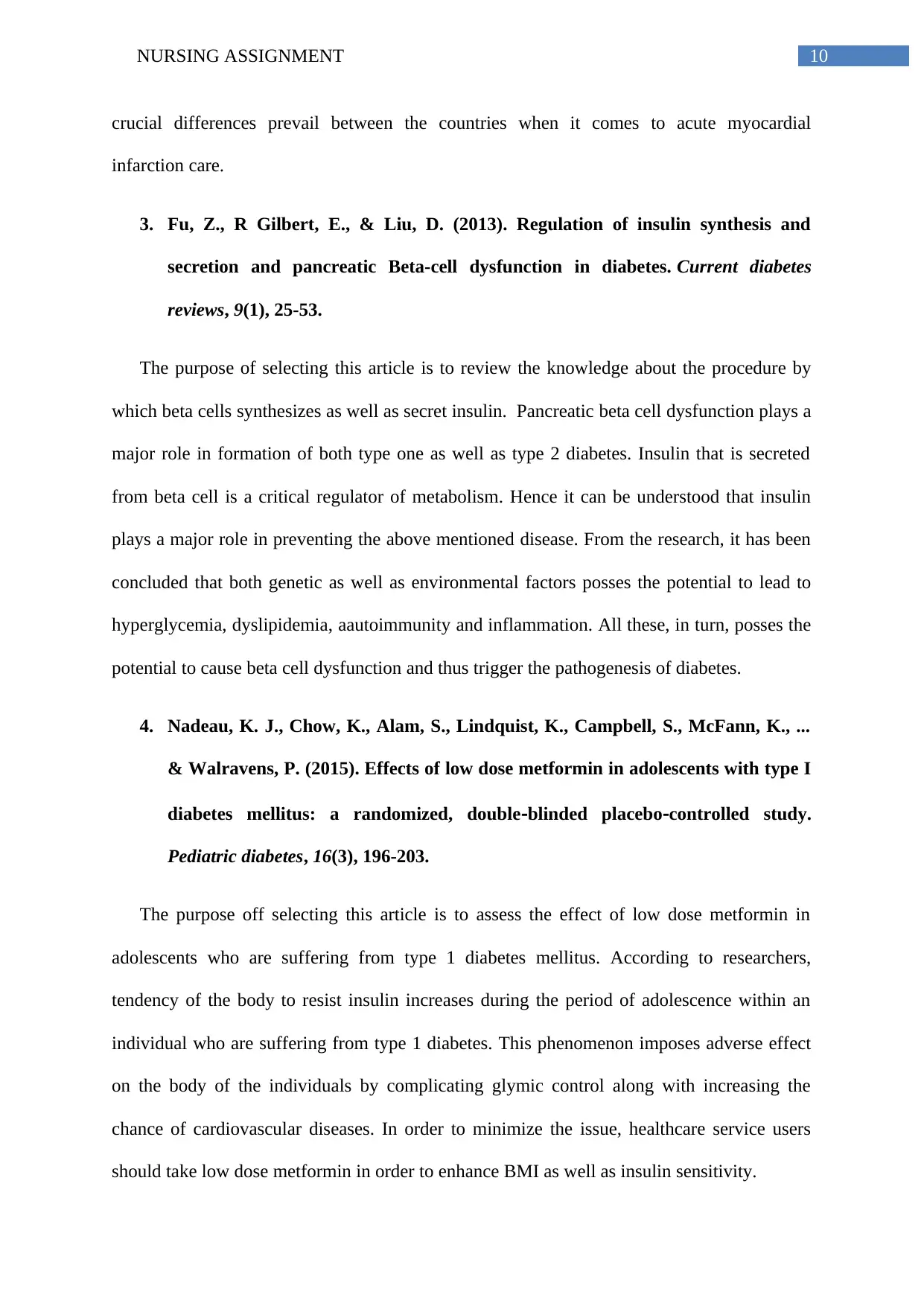
10NURSING ASSIGNMENT
crucial differences prevail between the countries when it comes to acute myocardial
infarction care.
3. Fu, Z., R Gilbert, E., & Liu, D. (2013). Regulation of insulin synthesis and
secretion and pancreatic Beta-cell dysfunction in diabetes. Current diabetes
reviews, 9(1), 25-53.
The purpose of selecting this article is to review the knowledge about the procedure by
which beta cells synthesizes as well as secret insulin. Pancreatic beta cell dysfunction plays a
major role in formation of both type one as well as type 2 diabetes. Insulin that is secreted
from beta cell is a critical regulator of metabolism. Hence it can be understood that insulin
plays a major role in preventing the above mentioned disease. From the research, it has been
concluded that both genetic as well as environmental factors posses the potential to lead to
hyperglycemia, dyslipidemia, aautoimmunity and inflammation. All these, in turn, posses the
potential to cause beta cell dysfunction and thus trigger the pathogenesis of diabetes.
4. Nadeau, K. J., Chow, K., Alam, S., Lindquist, K., Campbell, S., McFann, K., ...
& Walravens, P. (2015). Effects of low dose metformin in adolescents with type I
diabetes mellitus: a randomized, double‐blinded placebo‐controlled study.
Pediatric diabetes, 16(3), 196-203.
The purpose off selecting this article is to assess the effect of low dose metformin in
adolescents who are suffering from type 1 diabetes mellitus. According to researchers,
tendency of the body to resist insulin increases during the period of adolescence within an
individual who are suffering from type 1 diabetes. This phenomenon imposes adverse effect
on the body of the individuals by complicating glymic control along with increasing the
chance of cardiovascular diseases. In order to minimize the issue, healthcare service users
should take low dose metformin in order to enhance BMI as well as insulin sensitivity.
crucial differences prevail between the countries when it comes to acute myocardial
infarction care.
3. Fu, Z., R Gilbert, E., & Liu, D. (2013). Regulation of insulin synthesis and
secretion and pancreatic Beta-cell dysfunction in diabetes. Current diabetes
reviews, 9(1), 25-53.
The purpose of selecting this article is to review the knowledge about the procedure by
which beta cells synthesizes as well as secret insulin. Pancreatic beta cell dysfunction plays a
major role in formation of both type one as well as type 2 diabetes. Insulin that is secreted
from beta cell is a critical regulator of metabolism. Hence it can be understood that insulin
plays a major role in preventing the above mentioned disease. From the research, it has been
concluded that both genetic as well as environmental factors posses the potential to lead to
hyperglycemia, dyslipidemia, aautoimmunity and inflammation. All these, in turn, posses the
potential to cause beta cell dysfunction and thus trigger the pathogenesis of diabetes.
4. Nadeau, K. J., Chow, K., Alam, S., Lindquist, K., Campbell, S., McFann, K., ...
& Walravens, P. (2015). Effects of low dose metformin in adolescents with type I
diabetes mellitus: a randomized, double‐blinded placebo‐controlled study.
Pediatric diabetes, 16(3), 196-203.
The purpose off selecting this article is to assess the effect of low dose metformin in
adolescents who are suffering from type 1 diabetes mellitus. According to researchers,
tendency of the body to resist insulin increases during the period of adolescence within an
individual who are suffering from type 1 diabetes. This phenomenon imposes adverse effect
on the body of the individuals by complicating glymic control along with increasing the
chance of cardiovascular diseases. In order to minimize the issue, healthcare service users
should take low dose metformin in order to enhance BMI as well as insulin sensitivity.
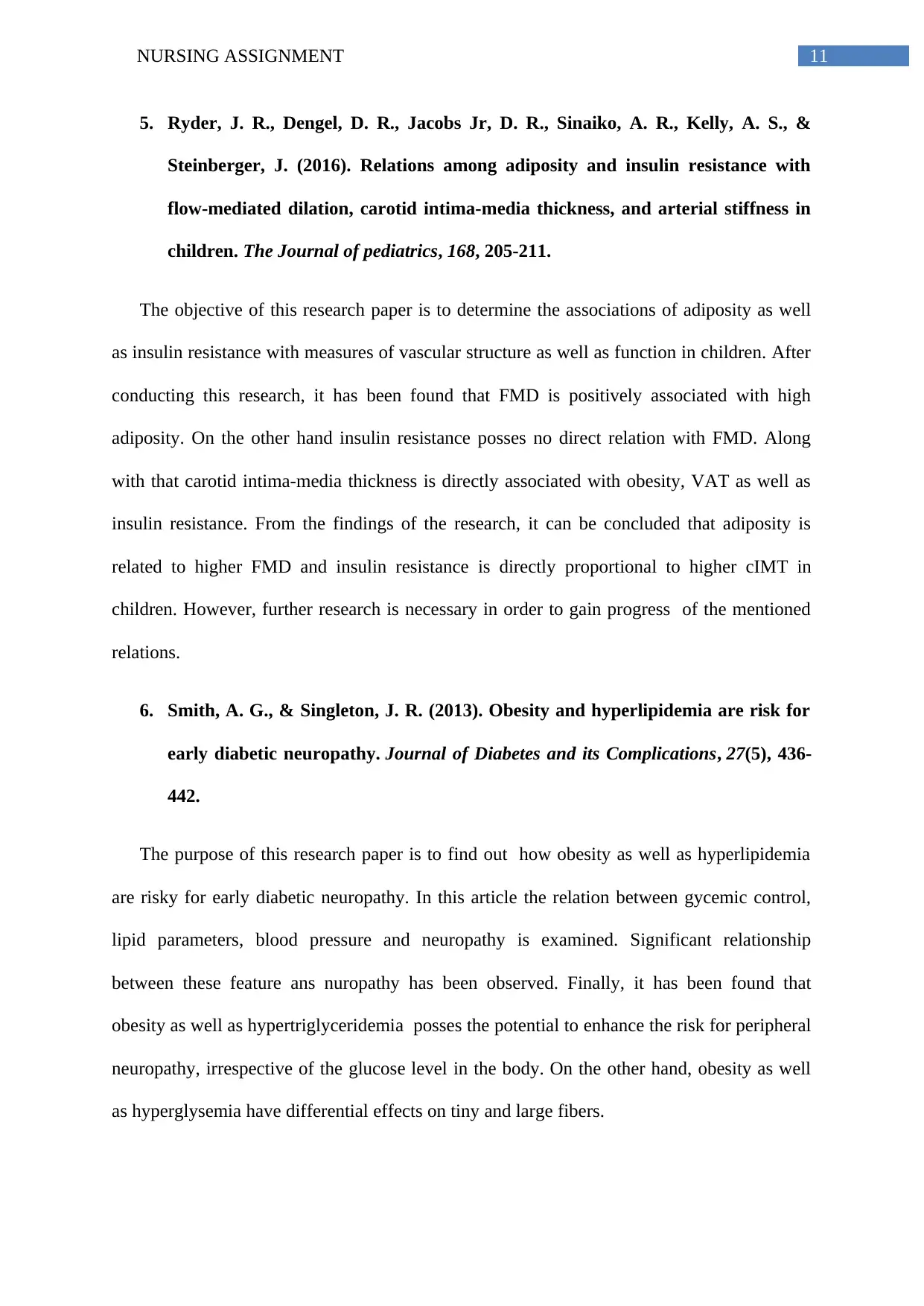
11NURSING ASSIGNMENT
5. Ryder, J. R., Dengel, D. R., Jacobs Jr, D. R., Sinaiko, A. R., Kelly, A. S., &
Steinberger, J. (2016). Relations among adiposity and insulin resistance with
flow-mediated dilation, carotid intima-media thickness, and arterial stiffness in
children. The Journal of pediatrics, 168, 205-211.
The objective of this research paper is to determine the associations of adiposity as well
as insulin resistance with measures of vascular structure as well as function in children. After
conducting this research, it has been found that FMD is positively associated with high
adiposity. On the other hand insulin resistance posses no direct relation with FMD. Along
with that carotid intima-media thickness is directly associated with obesity, VAT as well as
insulin resistance. From the findings of the research, it can be concluded that adiposity is
related to higher FMD and insulin resistance is directly proportional to higher cIMT in
children. However, further research is necessary in order to gain progress of the mentioned
relations.
6. Smith, A. G., & Singleton, J. R. (2013). Obesity and hyperlipidemia are risk for
early diabetic neuropathy. Journal of Diabetes and its Complications, 27(5), 436-
442.
The purpose of this research paper is to find out how obesity as well as hyperlipidemia
are risky for early diabetic neuropathy. In this article the relation between gycemic control,
lipid parameters, blood pressure and neuropathy is examined. Significant relationship
between these feature ans nuropathy has been observed. Finally, it has been found that
obesity as well as hypertriglyceridemia posses the potential to enhance the risk for peripheral
neuropathy, irrespective of the glucose level in the body. On the other hand, obesity as well
as hyperglysemia have differential effects on tiny and large fibers.
5. Ryder, J. R., Dengel, D. R., Jacobs Jr, D. R., Sinaiko, A. R., Kelly, A. S., &
Steinberger, J. (2016). Relations among adiposity and insulin resistance with
flow-mediated dilation, carotid intima-media thickness, and arterial stiffness in
children. The Journal of pediatrics, 168, 205-211.
The objective of this research paper is to determine the associations of adiposity as well
as insulin resistance with measures of vascular structure as well as function in children. After
conducting this research, it has been found that FMD is positively associated with high
adiposity. On the other hand insulin resistance posses no direct relation with FMD. Along
with that carotid intima-media thickness is directly associated with obesity, VAT as well as
insulin resistance. From the findings of the research, it can be concluded that adiposity is
related to higher FMD and insulin resistance is directly proportional to higher cIMT in
children. However, further research is necessary in order to gain progress of the mentioned
relations.
6. Smith, A. G., & Singleton, J. R. (2013). Obesity and hyperlipidemia are risk for
early diabetic neuropathy. Journal of Diabetes and its Complications, 27(5), 436-
442.
The purpose of this research paper is to find out how obesity as well as hyperlipidemia
are risky for early diabetic neuropathy. In this article the relation between gycemic control,
lipid parameters, blood pressure and neuropathy is examined. Significant relationship
between these feature ans nuropathy has been observed. Finally, it has been found that
obesity as well as hypertriglyceridemia posses the potential to enhance the risk for peripheral
neuropathy, irrespective of the glucose level in the body. On the other hand, obesity as well
as hyperglysemia have differential effects on tiny and large fibers.
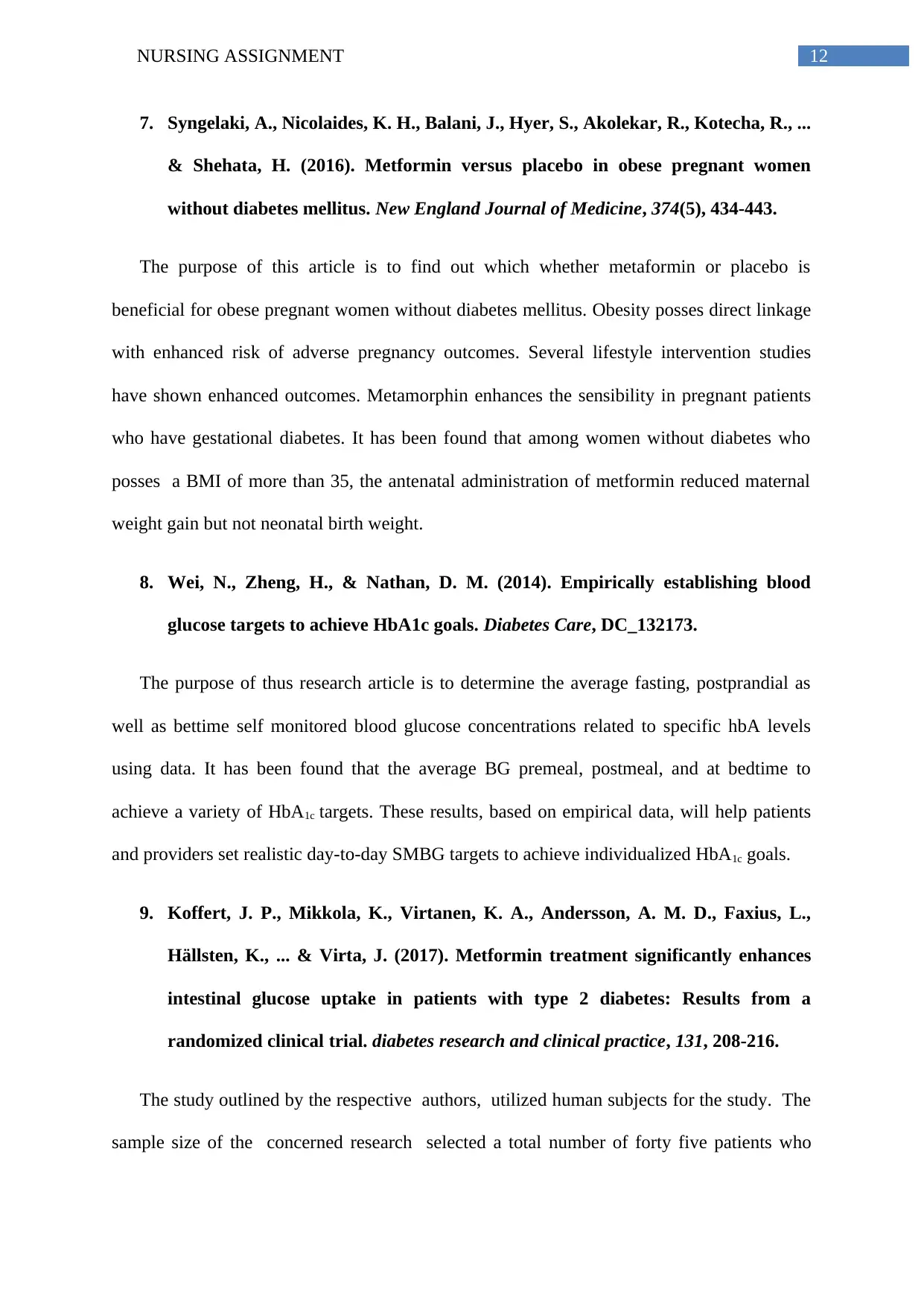
12NURSING ASSIGNMENT
7. Syngelaki, A., Nicolaides, K. H., Balani, J., Hyer, S., Akolekar, R., Kotecha, R., ...
& Shehata, H. (2016). Metformin versus placebo in obese pregnant women
without diabetes mellitus. New England Journal of Medicine, 374(5), 434-443.
The purpose of this article is to find out which whether metaformin or placebo is
beneficial for obese pregnant women without diabetes mellitus. Obesity posses direct linkage
with enhanced risk of adverse pregnancy outcomes. Several lifestyle intervention studies
have shown enhanced outcomes. Metamorphin enhances the sensibility in pregnant patients
who have gestational diabetes. It has been found that among women without diabetes who
posses a BMI of more than 35, the antenatal administration of metformin reduced maternal
weight gain but not neonatal birth weight.
8. Wei, N., Zheng, H., & Nathan, D. M. (2014). Empirically establishing blood
glucose targets to achieve HbA1c goals. Diabetes Care, DC_132173.
The purpose of thus research article is to determine the average fasting, postprandial as
well as bettime self monitored blood glucose concentrations related to specific hbA levels
using data. It has been found that the average BG premeal, postmeal, and at bedtime to
achieve a variety of HbA1c targets. These results, based on empirical data, will help patients
and providers set realistic day-to-day SMBG targets to achieve individualized HbA1c goals.
9. Koffert, J. P., Mikkola, K., Virtanen, K. A., Andersson, A. M. D., Faxius, L.,
Hällsten, K., ... & Virta, J. (2017). Metformin treatment significantly enhances
intestinal glucose uptake in patients with type 2 diabetes: Results from a
randomized clinical trial. diabetes research and clinical practice, 131, 208-216.
The study outlined by the respective authors, utilized human subjects for the study. The
sample size of the concerned research selected a total number of forty five patients who
7. Syngelaki, A., Nicolaides, K. H., Balani, J., Hyer, S., Akolekar, R., Kotecha, R., ...
& Shehata, H. (2016). Metformin versus placebo in obese pregnant women
without diabetes mellitus. New England Journal of Medicine, 374(5), 434-443.
The purpose of this article is to find out which whether metaformin or placebo is
beneficial for obese pregnant women without diabetes mellitus. Obesity posses direct linkage
with enhanced risk of adverse pregnancy outcomes. Several lifestyle intervention studies
have shown enhanced outcomes. Metamorphin enhances the sensibility in pregnant patients
who have gestational diabetes. It has been found that among women without diabetes who
posses a BMI of more than 35, the antenatal administration of metformin reduced maternal
weight gain but not neonatal birth weight.
8. Wei, N., Zheng, H., & Nathan, D. M. (2014). Empirically establishing blood
glucose targets to achieve HbA1c goals. Diabetes Care, DC_132173.
The purpose of thus research article is to determine the average fasting, postprandial as
well as bettime self monitored blood glucose concentrations related to specific hbA levels
using data. It has been found that the average BG premeal, postmeal, and at bedtime to
achieve a variety of HbA1c targets. These results, based on empirical data, will help patients
and providers set realistic day-to-day SMBG targets to achieve individualized HbA1c goals.
9. Koffert, J. P., Mikkola, K., Virtanen, K. A., Andersson, A. M. D., Faxius, L.,
Hällsten, K., ... & Virta, J. (2017). Metformin treatment significantly enhances
intestinal glucose uptake in patients with type 2 diabetes: Results from a
randomized clinical trial. diabetes research and clinical practice, 131, 208-216.
The study outlined by the respective authors, utilized human subjects for the study. The
sample size of the concerned research selected a total number of forty five patients who
Paraphrase This Document
Need a fresh take? Get an instant paraphrase of this document with our AI Paraphraser
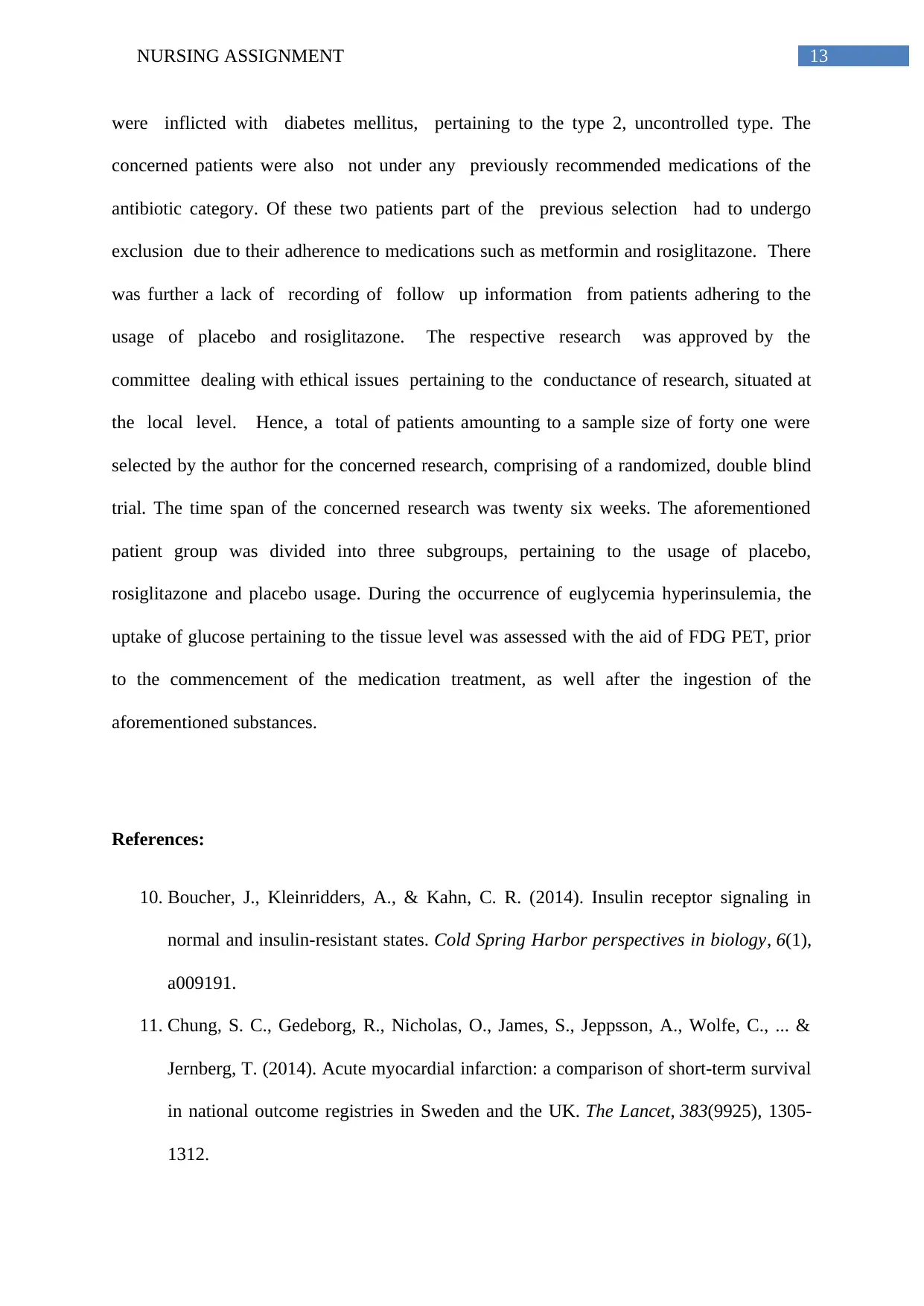
13NURSING ASSIGNMENT
were inflicted with diabetes mellitus, pertaining to the type 2, uncontrolled type. The
concerned patients were also not under any previously recommended medications of the
antibiotic category. Of these two patients part of the previous selection had to undergo
exclusion due to their adherence to medications such as metformin and rosiglitazone. There
was further a lack of recording of follow up information from patients adhering to the
usage of placebo and rosiglitazone. The respective research was approved by the
committee dealing with ethical issues pertaining to the conductance of research, situated at
the local level. Hence, a total of patients amounting to a sample size of forty one were
selected by the author for the concerned research, comprising of a randomized, double blind
trial. The time span of the concerned research was twenty six weeks. The aforementioned
patient group was divided into three subgroups, pertaining to the usage of placebo,
rosiglitazone and placebo usage. During the occurrence of euglycemia hyperinsulemia, the
uptake of glucose pertaining to the tissue level was assessed with the aid of FDG PET, prior
to the commencement of the medication treatment, as well after the ingestion of the
aforementioned substances.
References:
10. Boucher, J., Kleinridders, A., & Kahn, C. R. (2014). Insulin receptor signaling in
normal and insulin-resistant states. Cold Spring Harbor perspectives in biology, 6(1),
a009191.
11. Chung, S. C., Gedeborg, R., Nicholas, O., James, S., Jeppsson, A., Wolfe, C., ... &
Jernberg, T. (2014). Acute myocardial infarction: a comparison of short-term survival
in national outcome registries in Sweden and the UK. The Lancet, 383(9925), 1305-
1312.
were inflicted with diabetes mellitus, pertaining to the type 2, uncontrolled type. The
concerned patients were also not under any previously recommended medications of the
antibiotic category. Of these two patients part of the previous selection had to undergo
exclusion due to their adherence to medications such as metformin and rosiglitazone. There
was further a lack of recording of follow up information from patients adhering to the
usage of placebo and rosiglitazone. The respective research was approved by the
committee dealing with ethical issues pertaining to the conductance of research, situated at
the local level. Hence, a total of patients amounting to a sample size of forty one were
selected by the author for the concerned research, comprising of a randomized, double blind
trial. The time span of the concerned research was twenty six weeks. The aforementioned
patient group was divided into three subgroups, pertaining to the usage of placebo,
rosiglitazone and placebo usage. During the occurrence of euglycemia hyperinsulemia, the
uptake of glucose pertaining to the tissue level was assessed with the aid of FDG PET, prior
to the commencement of the medication treatment, as well after the ingestion of the
aforementioned substances.
References:
10. Boucher, J., Kleinridders, A., & Kahn, C. R. (2014). Insulin receptor signaling in
normal and insulin-resistant states. Cold Spring Harbor perspectives in biology, 6(1),
a009191.
11. Chung, S. C., Gedeborg, R., Nicholas, O., James, S., Jeppsson, A., Wolfe, C., ... &
Jernberg, T. (2014). Acute myocardial infarction: a comparison of short-term survival
in national outcome registries in Sweden and the UK. The Lancet, 383(9925), 1305-
1312.
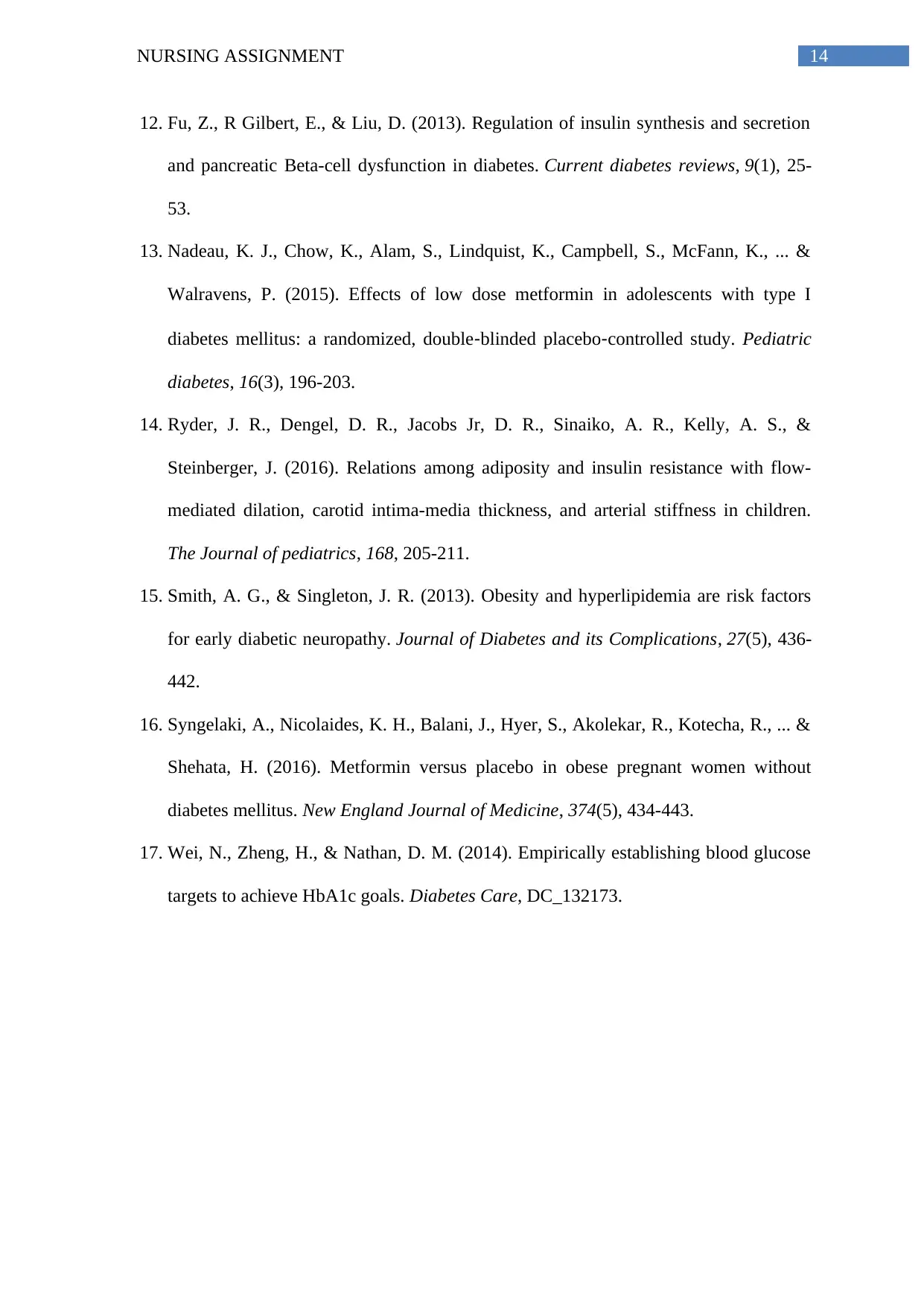
14NURSING ASSIGNMENT
12. Fu, Z., R Gilbert, E., & Liu, D. (2013). Regulation of insulin synthesis and secretion
and pancreatic Beta-cell dysfunction in diabetes. Current diabetes reviews, 9(1), 25-
53.
13. Nadeau, K. J., Chow, K., Alam, S., Lindquist, K., Campbell, S., McFann, K., ... &
Walravens, P. (2015). Effects of low dose metformin in adolescents with type I
diabetes mellitus: a randomized, double‐blinded placebo‐controlled study. Pediatric
diabetes, 16(3), 196-203.
14. Ryder, J. R., Dengel, D. R., Jacobs Jr, D. R., Sinaiko, A. R., Kelly, A. S., &
Steinberger, J. (2016). Relations among adiposity and insulin resistance with flow-
mediated dilation, carotid intima-media thickness, and arterial stiffness in children.
The Journal of pediatrics, 168, 205-211.
15. Smith, A. G., & Singleton, J. R. (2013). Obesity and hyperlipidemia are risk factors
for early diabetic neuropathy. Journal of Diabetes and its Complications, 27(5), 436-
442.
16. Syngelaki, A., Nicolaides, K. H., Balani, J., Hyer, S., Akolekar, R., Kotecha, R., ... &
Shehata, H. (2016). Metformin versus placebo in obese pregnant women without
diabetes mellitus. New England Journal of Medicine, 374(5), 434-443.
17. Wei, N., Zheng, H., & Nathan, D. M. (2014). Empirically establishing blood glucose
targets to achieve HbA1c goals. Diabetes Care, DC_132173.
12. Fu, Z., R Gilbert, E., & Liu, D. (2013). Regulation of insulin synthesis and secretion
and pancreatic Beta-cell dysfunction in diabetes. Current diabetes reviews, 9(1), 25-
53.
13. Nadeau, K. J., Chow, K., Alam, S., Lindquist, K., Campbell, S., McFann, K., ... &
Walravens, P. (2015). Effects of low dose metformin in adolescents with type I
diabetes mellitus: a randomized, double‐blinded placebo‐controlled study. Pediatric
diabetes, 16(3), 196-203.
14. Ryder, J. R., Dengel, D. R., Jacobs Jr, D. R., Sinaiko, A. R., Kelly, A. S., &
Steinberger, J. (2016). Relations among adiposity and insulin resistance with flow-
mediated dilation, carotid intima-media thickness, and arterial stiffness in children.
The Journal of pediatrics, 168, 205-211.
15. Smith, A. G., & Singleton, J. R. (2013). Obesity and hyperlipidemia are risk factors
for early diabetic neuropathy. Journal of Diabetes and its Complications, 27(5), 436-
442.
16. Syngelaki, A., Nicolaides, K. H., Balani, J., Hyer, S., Akolekar, R., Kotecha, R., ... &
Shehata, H. (2016). Metformin versus placebo in obese pregnant women without
diabetes mellitus. New England Journal of Medicine, 374(5), 434-443.
17. Wei, N., Zheng, H., & Nathan, D. M. (2014). Empirically establishing blood glucose
targets to achieve HbA1c goals. Diabetes Care, DC_132173.

15NURSING ASSIGNMENT
1 out of 16
Related Documents
Your All-in-One AI-Powered Toolkit for Academic Success.
+13062052269
info@desklib.com
Available 24*7 on WhatsApp / Email
![[object Object]](/_next/static/media/star-bottom.7253800d.svg)
Unlock your academic potential
© 2024 | Zucol Services PVT LTD | All rights reserved.





